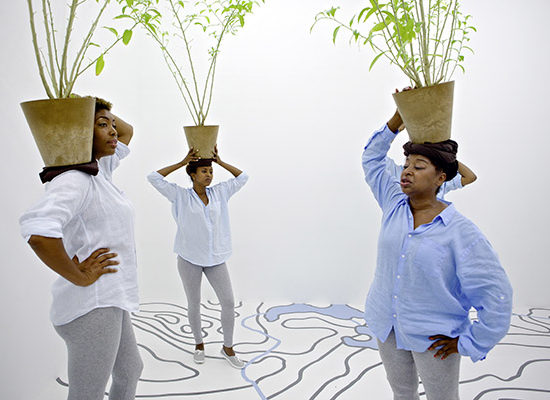This year hasn’t even come to an end. Yet, intrepid gallerists and collectors are no doubt already pulling out their calendars to mark out the fair circuit for the year 2015. To help weed out the best from the rest, artnet News’ European editors sorted through the stacks of notes and reports from the year’s fairs to see who came out on top in 2014. Time to book your flights.
1. Art Basel
No surprise here, but the cliché is as true as ever: Art Basel remains the industry’s mecca. It’s is the fair to buy at, the one to be seen at—the one that museum curators all show up for. And it’s working hard to keep its place ahead of the curve. At the latest edition, the Unlimited section dedicated to monumental artworks had the air of a mini biennial. The fair also bravely embraced performance—still the most commercially challenging medium—with 14 Rooms, a sprawling exhibition of live art, courtesy of star curators Hans Ulrich Obrist and Klaus Biesenbach. Curatorial flourishes aside, business at the Messe was particularly brisk, with major pieces by Andy Warhol, Damien Hirst, and Jeff Koons selling like hotcakes as soon as the doors opened. Art Basel still reigns supreme over all the other fairs, in Europe and elsewhere.
2. Frieze London
Following the opening of Frieze Masters in 2012, Frieze London sometimes felt like the lesser-loved sibling, but the 2014 edition proved that the London contemporary art fair has now regained the organizers’ full attention. A grand design overall made the big tent much easier to navigate. It radically transformed the mood in the aisles, and, according to the dealers artnet News spoke to, had a positive impact on sales. The year 2015 marks the beginning of a new chapter for Frieze. Co-founders Matthew Slotover and Amanda Sharp have stepped aside and handed over the day-to-day oversight of the three fairs to Frieze veteran Victoria Siddall. All eyes will be on the new director next May, as she inaugurates her “first” Frieze New York.
3. FIAC (Paris)
FIAC may have ended the year’s new cycle on a bad note, mysteriously canceling the inaugural edition of its LA outpost for 2015, but back in its hometown of Paris this past October, the Grand Palais’s aisles were full of nothing but praise. Under Jennifer Flay’s direction, the fair has firmly secured its spot as the fall European marketplace for serious conceptually-driven works. And this year it debuted a self-designed satellite, (Off)icielle, for young galleries too, paving the way for many years of success to come.
4. TEFAF (Maastricht)
Described by one dealer as a “one-stop-shop,” TEFAF’s offering is without a doubt the most varied of the lot, ranging from Lucas Cranach paintings to rare Chinese ceramics, jewelery, and, this past March, a handful of Damien Hirst works. But variety doesn’t mean amateurism here: TEFAF is all about scholarship. The latest edition gathered over 30,000 objects—worth collectively an estimated €4 billion (US$5.54 billion)—each of them vetted by a committee of experts. This makes TEFAF an ideal place for museum acquisitions. Several major collectors are also said to have made their only fair outing of the year.
5. Paris Photo
France’s premier photo fair just lost its director, Julien Frydman. But he leaves the fair at what many have considered its pinnacle. His four years at the fair have seen it open up significantly to a wider spectrum of the art market: 55 percent of galleries this year didn’t specialize in photography, up from 10 percent in 2010. Thirty-one galleries exhibited at Paris Photo for the first time in 2014. And fair attendance was almost double where it stood four years ago.
6. Art Cologne
The world’s oldest art fair, Art Cologne might not have the flash and glamour of some other fairs, but in terms of market power for contemporary art, it is likely unmatched on the spring circuit in Europe. Sales at this year’s edition marked a new highpoint for Art Cologne. The quality of works on view was markedly higher than in 2013.
7. Art Brussels
Falling two weeks after Cologne for the first time in several years, Art Brussels offers a colorful, upbeat alternative to its German neighbor. Sales at Art Brussels on the whole, were slightly less plentiful or high-reaching in artnet News’ perusal at Art Cologne. But it has firmly planted itself as a venue at which to discover new artists. And, with the European capital housing ever-increasing numbers of France’s elite, the fair is sure to continue an upward trajectory.
8. Liste (Basel)
The only satellite fair to make our list, Liste was once again an important temperature-taker of key trends and emerging artistic positions this year. Held annually during Art Basel week, the fair continues to attract a loyal collector base and assembles the freshest group of galleries to be seen anywhere at any time on the art world calendar.
9. Artissima (Turin)
Artsissima continues to take that Liste format and make a fair out of it. For that audacious approach alone, were sales better, you would see the fair jump a spot in this ranking. Curators flock to the fair each year, and 2014 saw the new introduction of a section dedicated to performance. But major collectors—save a handful of loyal locals—don’t typically make the trek. Really, though, they should.
10. Art Berlin Contemporary
Where sales were concerned, many dealers reported that ABC’s 2014 edition was its most successful yet. Director Maike Cruse was particularly adept at luring in relatively small but eager German collectors from the provinces this year. And though the fair got off to a slow start, things finished in a big way. The quality of works on view was slightly on the wane over the 2012 and 2013 editions, however, and that’s something the fair will need to keep an eye on if it wants to keep bringing buyers back.
